Culture is the foundation of the consensus on the value of digital encrypted currency, and the dissemination of the consensus on value cannot be separated from the unique culture of encrypted currency. Value consensus is Meme, and encrypted currency cannot escape the phenomenon of Meme. BTC is the earliest and largest Meme. BTC directly implanted its core culture into the genesis block through a news reprint, ultimately achieving the self-bootstrapping of BTC.
Restoring the on-chain culture and the decentralized culture is a feasible method to return to the spontaneous self-bootstrapping of BTC. The appearance of Ordi and Sats inscriptions directly implanted code information into the BTC community, serving as the spontaneous starting point of the BTC cultural renaissance. The convergence of encrypted culture and technology will consciously bind encrypted assets and culture through the method of content on-chain, which will be a direction for the development of inscription 2.0.
01. Prologue
At around 6:15 pm on January 3, 2009, the genesis block of Bitcoin was born on a small server in Helsinki, Finland. In this genesis block, Satoshi Nakamoto recorded a piece of news from The Times in the script area:
"January 3, 2009, the Chancellor on brink of second bailout for banks"
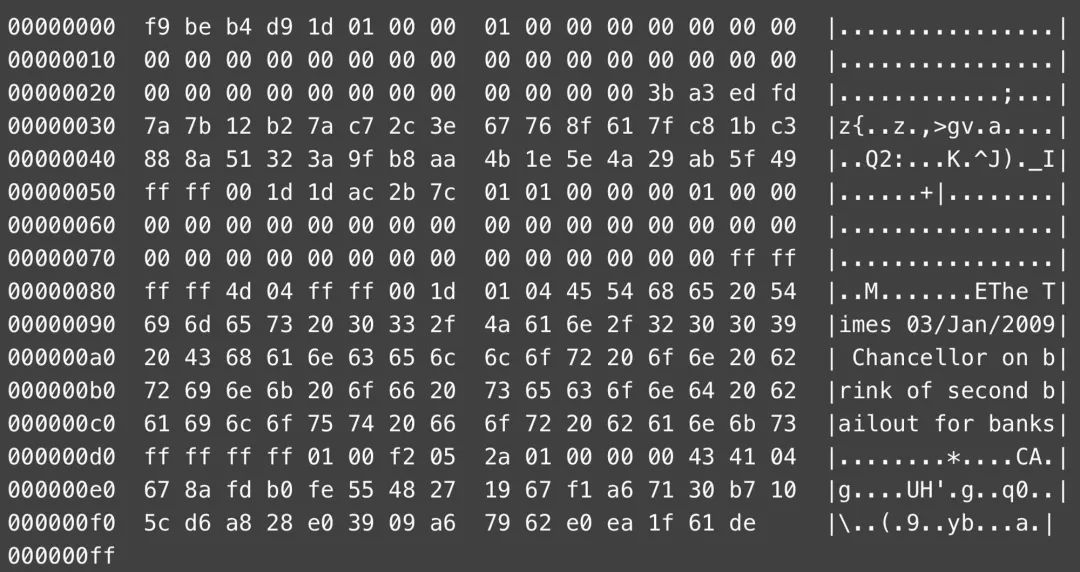
Thus, the era of the great voyage of the encrypted world began. Adventurers, visionaries, and capitalists set sail in pursuit of the treasures of the encrypted world, seeking their own belonging.
Thirteen years have passed in the blink of an eye, and Satoshi Nakamoto has ascended to the godly position, with his whereabouts unknown. The script area of BTC once again ushered in a glorious moment. This is because with the SegWit and Taproot upgrades of BTC, the space recorded by BTC once again returned to everyone's view. The appearance of inscriptions unearthed the value of the storage space on BTC: this is a storage space defended by a network with over 400 million TH/s of computing power. Using this space as a ledger, its security is stronger than any other blockchain. The route of inscription technology is the exploration of the technical route of the BTC chain as a multi-asset financial certification platform. The existence of inscription value is to demonstrate the value of the BTC script space under this architecture.
And this is just the beginning of the revival of BTC. Members of the encrypted community began to reflect on the original understanding of BTC: BTC can not only serve as the ledger of BTC, but also as the ledger of other assets! Following this is a reflection on the behavior of Satoshi Nakamoto. What is the significance of re-posting a paper newspaper on the storage space of BTC? What is the significance of repeatedly loading human-readable content from the chain onto the chain?
Answering this question solves the product motivation for social content on the chain.
02. Value Consensus = Meme!
Newcomers to the coin circle, especially those who come from the blockchain circle, are often confused by projects like EOS, which are technologically advanced, have good user experience, but have a dismal valuation. This is because they have not distinguished between technical consensus and value consensus.
2.1 Consensus is divided into technical route consensus and value-oriented consensus
The value of BTC was also created from scratch, ultimately achieving self-bootstrapping of value. In the process of achieving self-bootstrapping of value, the community not only needs to reach a technical consensus, but also a value consensus. Merely achieving a technical consensus does not mean having a strong value consensus. Take EOS as an example. Many technical personnel are troubled by the valuation of EOS: the technology is good, so why is the price so low? Even today, the on-chain user experience and ecosystem applications are not inferior to Ethereum. However, all the technical barriers and ecosystem advantages cannot prevent people from selling EOS to buy BTC and ETH. This kind of operation makes EOS a tool for the team to exploit in the eyes of community members. When an asset forms a stereotyped impression in the eyes of investors, it requires tremendous capital power to reverse the consensus. Without the support of capital, coupled with the departure of core members, even a good product cannot support the valuation of EOS.
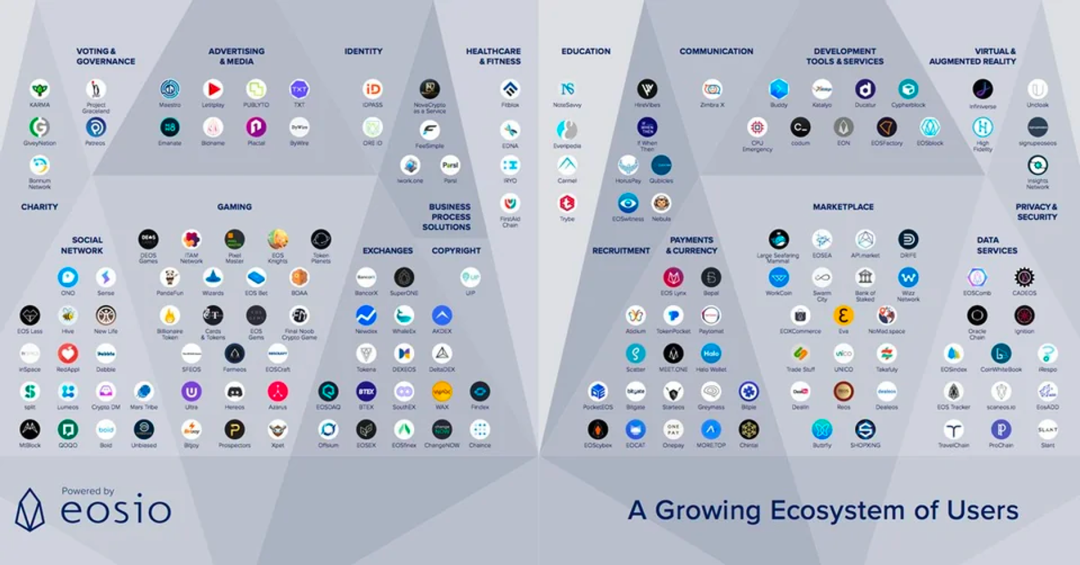
The panoramic view of the EOS ecosystem in 2018: the grandeur of the old days
On the other hand, the originator of Meme coins, Doge, did not even have any developers left before Elon Musk tweeted about it. Musk's tweet made most investors believe that with Musk's social influence, Doge would be seen, recognized, liked, and held by more people. The diffusion of consensus on the token relies on Musk as the source of dissemination, which gives wings to the project. This kind of community consensus propelled Doge's price from $0.014 to as high as $0.8.
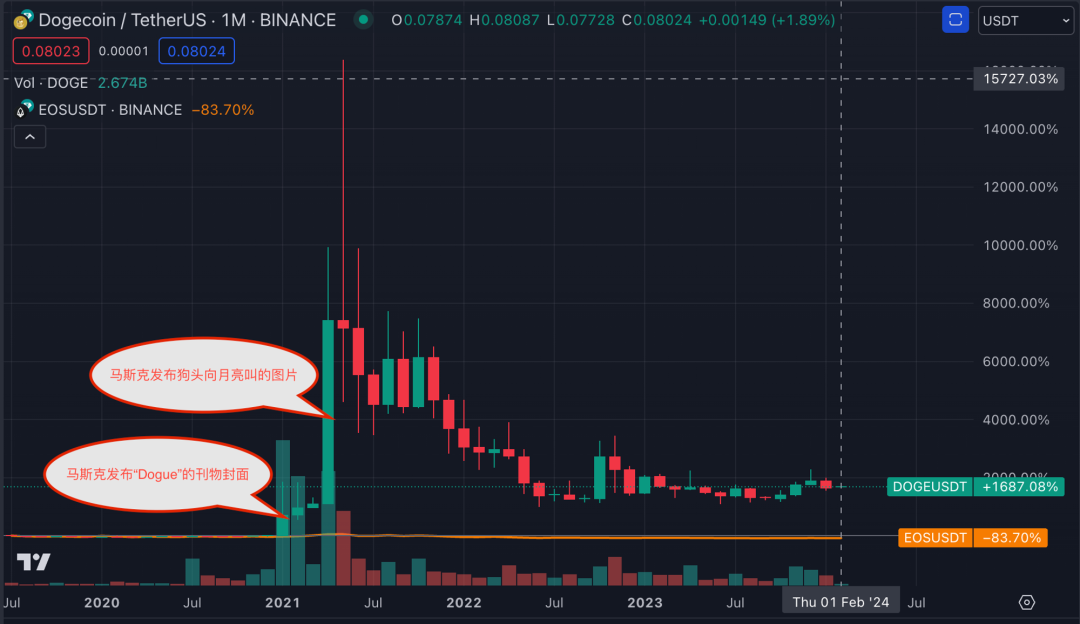
Two examples: EOS has good technology and products, but has a low valuation. Doge is purely a Meme, without an ecosystem or technology, yet it has a high valuation: technical consensus does not equate to value consensus.
2.2 The process of reaching value-oriented consensus is the process of forming Meme
The technical consensus of BTC ensures that each account can fully control its own permissions and that double spending does not exist. Since the birth of BTC, the technical consensus has been borne by the BTC technical white paper. From having no price to having a price, from having people mining to truly achieving payments, BTC went through a year and a half. During this year and a half, the BTC community members continuously reflected not only on whether BTC was secure enough as a chain, but also on whether BTC was valuable, and how valuable it was. This is the consensus on value. Value consensus is always subjective. The foundation of the value consensus of BTC is "The Denationalization of Money" and the FUD about the centralization of money. The news written into the genesis block is the seed and the fuse of FUD. If this news had not been reprinted in the genesis block, it would have long been buried in the vast archives of The Times.
Satoshi Nakamoto is a master of attention. When reviewing the successful launch of BTC, Satoshi Nakamoto has always been flattering the big shots in the encrypted community. For example, he showed David that BTC had already realized the concept of B-cash proposed by David, and received David's endorsement offline. This kind of endorsement directly established the brand within the community for BTC, thereby gaining community attention. On January 12, 2009, Hal Finney received 10 bitcoins from Satoshi Nakamoto for testing Bitcoin transactions, becoming the first recipient of a Bitcoin transaction. After that, Satoshi Nakamoto often transferred mined BTC to friends in the encrypted community, gaining the attention of community members through this behavior. This behavior later evolved into one of the unique ways for encrypted projects to build attention: airdrops!
Looking back at the first real-world transaction of BTC, Laszlo Hanyecz purchased two pizzas for 10,000 BTC. In this exchange, BTC gained a price for the first time. Both parties to the transaction were aware of BTC. The premise for both parties to reach a consensus on the purchasing power of BTC is their mutual recognition of the value narrative of BTC. By engraving the meaningful news headline in the genesis block, Satoshi Nakamoto automatically conveyed the value narrative of BTC every time a BTC evangelist explained the history of BTC. This is the most direct and efficient way to capture value.
2.3 The fluctuation of coin prices cannot escape the phenomenon of Meme
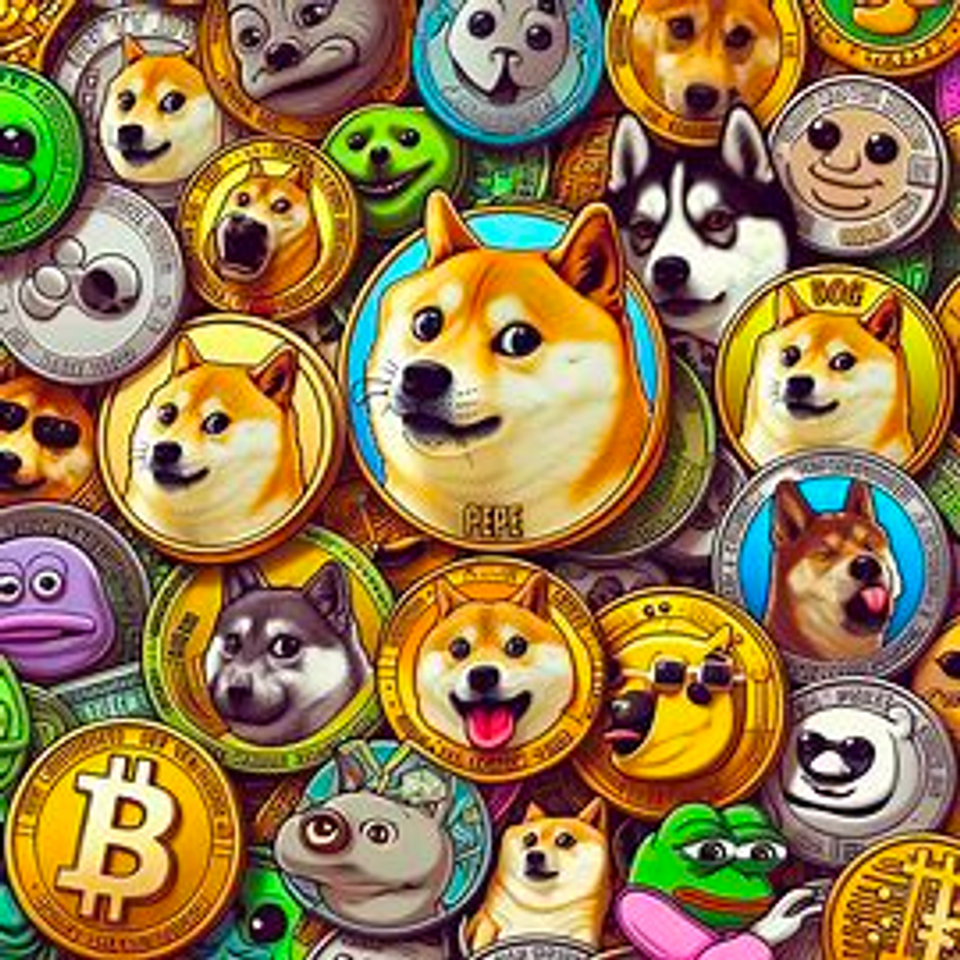
Everything is Meme.
Most coins are Meme coins. Looking back at other tokens in the coin circle, there are many mainstream tokens (UNI, ARB, OP) without clear value capture support. For more assets, it is difficult to distinguish between rights and obligations, and even more difficult to find effective value capture. The valuation of the coin circle cannot be explained by monetary theory or financial assets. BTC is claimed to be a peer-to-peer electronic cash payment system, but how many people actually use BTC for payments today? Boldly speaking, BTC is the biggest Meme. The price of the coin is a matter of Meme. It is precisely because of its Meme properties that the assets in the coin circle have a different attribute from traditional finance, attention. Its fluctuation cycle is also different from traditional finance.
Even the value of utility tokens contains elements of Meme. The pricing of financial assets ultimately depends on supply and demand. Supply and demand stem from changes in human decision-making, which are influenced by emotions affected by information. Behavioral finance has long been a consensus in the investment industry. The traditional financial value represented by tokens and Meme are not mutually exclusive. Meme can enhance the valuation of utility tokens, but it can also reduce the value of utility tokens.
Therefore, we say that the price of the coin is a matter of Meme.
In the short term, the price of the coin can be manipulated by patterns, but in the long term, the size of the community holding the token and the willingness to hold the token depend on whether the value proposition is successful. Just like Apple phones, even if the cost-effectiveness is low, users still buy into it. Only long-term believers and holders are the support for the value of the token. And these believers and holders are inspired by culture.
2.4 The achievement of consensus requires cultural dissemination
The technical consensus of tokens and the value consensus of tokens are formed through different paths. Technical consensus helps to form the value consensus of tokens. However, both technical consensus and value consensus contain emotional elements, and people tend to rely on intuition. Therefore, unlike copying cold code on different computers, consensus is spread among people and requires warm content as a carrier. This warm content spread among people is what we usually define as social content.
All Crypto projects are in agreement on the importance of building a brand and establishing cognitive value consensus through social media and social content. Almost all the project teams I know have their own social accounts and private social spaces for dissemination. From community operations to group mods, project teams form their own community teams. Social accounts become the source of dissemination, and the community or a series of encrypted small circles become the channels of dissemination.
BTC's technical white paper is calm and objective, but the news engraved in the genesis block is warm. This news reflects the value orientation that Satoshi Nakamoto wanted to promote to BTC followers. As long as BTC exists, this excerpt advocating the value orientation of BTC will not stop its dissemination, as the genesis block has been deployed in various parts of the world with full nodes. Every time this excerpt is read, people are reminded of the impending doomsday of centralized central banks. If we consider BTC as a religion, then "British Chancellor's Relief" is the doomsday prophecy of this religion. And BTC is the Maitreya, the Messiah, the Noah's Ark in the apocalypse.
The coin circle has always been the most knowledgeable about cultural dissemination. Just looking at the recent wave of inscriptions, various small images and slogans are used to let more people understand the Meme culture represented by four letters. Unfortunately, the dissemination area still mainly consists of Web2 social media, and Meme itself does not have a strong value orientation like BTC. Many inscriptions in their dissemination cannot find their own positioning. Successful inscriptions occupy the orthodox position of inscriptions on the one hand, and on the other hand, they form a unique culture in the narrative, such as the "1 sats=1 sats" in the Sats community.
In conclusion, cultural content is the carrier of value orientation. This understanding coincides with the Meme theory. Meme is the unit of information dissemination in cultural communication. Culture here refers to ideas, concepts, customs, artistic forms, etc. In order to support the price of tokens, designers must consider the relationship between culture and token price in the process of cultural dissemination. The memes contained in BTC have set a good example for the encrypted circle, but unfortunately, many tokens claiming to be "memes" often only pursue the dissemination cost of "memes" and abandon the relationship between "memes" and token value. After BTC, there are only token names with memes, and no longer narratives with memes.
03. Content on the Chain: Capturing Native Attention on the Chain
Capturing native attention on the chain through content on the chain is currently a very rare content on-chain strategy. Other tracks have not formed a continuous economic cycle and are mostly in the experimental stage.
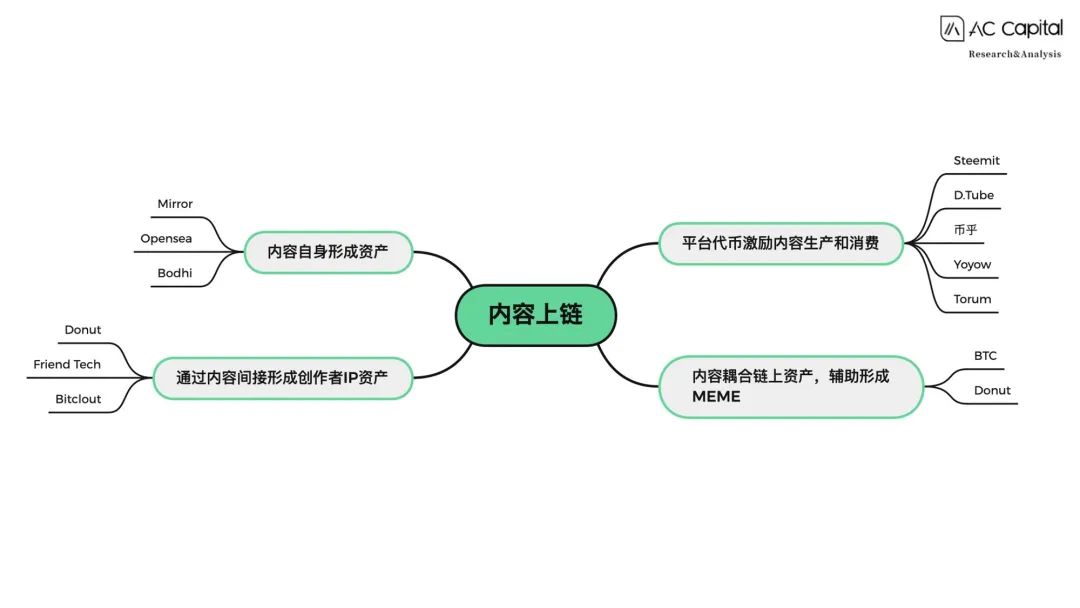
3.1 Widely achieving value-oriented consensus requires capturing attention
To achieve value consensus, information outreach is needed. In modern society, the cost of content creation is almost zero, and attention has become a scarce commodity compared to the overwhelming content. From mainstream media space to KOL positions, from Web2 to Web3, project operations cannot ignore the importance of attention. Since the appearance of the first generation of print media, attention has become the main trading commodity of the media. And in the Web2 era, those platforms that control traffic distribution view traffic distribution as the source of platform monopoly profits.
In the traditional business world, advertising for goods is to make consumers aware of the goods themselves and to promote their attributes and value propositions. However, the highest-end advertisements often use value proposition output. Multinational giants such as Apple and Huawei often understand this when providing differentiated brand products. This value proposition output is no different from the value proposition output of digital encrypted assets.
In the traditional field, the methods of capturing attention in the coin circle are also similar. There are event-based marketing such as auctioning an NFT for tens of millions of dollars at Sotheby's, activity-based marketing such as hosting a party on a cruise ship, and brand marketing such as sponsoring the naming rights of a stadium.
The coin circle also has on-chain information channels. For example, BTC's inscriptions, although only four characters, directly inject Meme information into the core of the BTC community. Whether in favor or against inscriptions, the appearance of inscriptions forces members of the BTC community to take a stand. This on-chain information is eternal and open. All inscriptions that comply with the rules can be engraved on the BTC blockchain and read by people. The process of creating inscriptions is equivalent to liking a certain segment of information at a specific address, which is a public display of attitude. However, traditional on-chain inscriptions have too few on-chain information, and the expression of community members' attitudes is too monotonous.
Undeniably, Satoshi Nakamoto's choice of content is exquisite. Perhaps other content cannot pierce the fragility of centralized finance like this news. In this unprecedented marketing campaign, we see the value of recording social content in the genesis block. It is the eternal genesis space of BTC that has pushed this exquisite narrative material into the spotlight of the attention of the coin circle, and it has become more prominent as the consensus of the blockchain and BTC grows.
On-chain media is different from traditional media, not only in terms of technical routes and business logic, but also in terms of the covered population.
3.2 Web3 Media Industry: Content on the Chain is a Core Content Filter Based on P/E Ratio
In the history of blockchain, many projects have considered doing traditional media-like business on the blockchain, but due to efficiency issues, whether it is textual media, multimedia, or short videos, it is difficult to collect attention like in the Web2 world. Regardless of product form or content sedimentation within the product, Web3 media products lag far behind Web2 media. Even with the subsidy of financial tokens, Web3 media products cannot compete with the attractiveness of Web2 products. The content algorithms of products such as TikTok, Instagram, and YouTube have already reached their peak.
The challenge of Web3 media to Web2 can only take a different path. BTC inscriptions are an alternative form of content on the chain. Although there are only four characters on the chain, these four characters are indeed rooted in the BTC community. Taking the inscription Sats as an example, the total cost of creating the inscription amounted to tens of millions of dollars. The community used real money to demonstrate the value of the Sats culture. According to the current data in the Unisats market, there are fewer than 1800 BTC inscriptions, and compared to traditional Web2 media, a large amount of content has been filtered out. From this perspective, the method of content on the chain through inscriptions is a core content filter based on the P/E ratio. Only cultural Meme that can afford the cost and are considered to have potential can occupy a place in the inscription market.
Content filters are also concentrators of attention. With attention remaining constant, by increasing the cost to reduce the total amount of content, the same content can receive more attention.
3.3 Attention Focus: How does on-chain content participate in the competition for attention
As mentioned earlier, compared to Web2, on-chain content is like a code, dull and uninteresting. Can on-chain content really compete with Web2 media content and vie for scarce attention resources? The answer is yes.
3.3.1 Profit-oriented Attention Collection
On-chain content is like a code, but it is a code of wealth. The thousandfold increase in prices is like a hook for attention, luring those who want to get rich. If someone wants to find the wealth code in the inscriptions and attempt to change their destiny, they can directly search for information on these inscriptions exchanges according to the rankings and charts, where they can find more information. The trading volume and price fluctuations are the industry's secret language. Those who are interested will conduct more detailed investigations into the culture, community, and even the distribution of personnel chips corresponding to the inscriptions, based on the inscriptions' codes, by joining various Web2 media and offline circles.
The success of the inscription ecosystem tells us that on-chain content can collect attention through profit orientation. The same goes for BTC; the higher the price of BTC, the more people will pay attention to it, leading to an understanding of the genesis block and the plight of the British Chancellor in 2009, thus gaining a vivid understanding of the urgency of decentralization.
Profit-oriented attention also has another meaning. The value of attention should be related to its wealth control, not to the number of people. For example, if an on-chain media can only reach 1% of the world's population, but this portion of people can control 50% of the social wealth, then the advertising value of such media must be much greater than that of media that can reach 50% of the world's population but only influence 10% of the social wealth. High-end circle marketing follows this path. On-chain content media fully leverages this advantage. When a person's interests are more tied to a particular on-chain asset, they will pay more attention to the content related to that asset.
3.3.2 Enclosed Traffic Collection in Web3
On-chain content has a certain degree of enclosure. Users of Unisats and OK Wallet are dedicated users. Their attention will not be diverted elsewhere by entertaining videos or text. In the enclosed space of on-chain content, the content is extremely limited. Although attention may not be as great as in traditional Web2, the different ways of guiding attention determine the relative enclosure of this attention. On-chain life is in a process of gradual development, with more and more people starting Web3 accounts and entering the Web3 world. This part of attention will grow stronger with massive adoption. On one hand, there is enclosed attention, and on the other hand, there is a continuously growing flow of attention. The competition for attention in on-chain content is promising in the future.
Enclosure is also evident in the independent and unchangeable nature of on-chain content space. When much media information has been inundated by the information tide, only on-chain information is relatively clear and accessible, and is not afraid of being deleted or tampered with. This property is particularly suitable for maintaining the core attributes of Meme culture.
3.3.3 Comprehensive Coupling of Assets and Content
By using the inscription method to put content on the chain, the content becomes intertwined with the trading of tokens, making it difficult to separate. This data structure ensures that the content and assets are sufficiently close in space. This brings us back to the successful theory of BTC and BTC inscriptions. It is because the excerpt from The Times was engraved in the genesis block of BTC that the believers in BTC were able to be energized by the vulnerability of centralization time and time again. By implanting the inscription JSON code, which is like "dust," into the BTC script, the Meme culture of the inscription can be connected to the BTC community. This is a content delivery targeting the community and assets, and the pursuit of attention is also precise.
In conclusion, on-chain content can challenge Web2's attention capture in terms of value, enclosure, and user precision. Therefore, content on the chain is not only feasible, but has already been successful in the era of BTC bootstrap. During the subsequent period of on-chain ICOs, the continuously hatching Meme has also repeated the successful content on-chain. It's just that we are immersed in learning the content on-chain methods of traditional Web2 media, and turning a blind eye to the successful cases of content on-chain.
04. Social Inscriptions: The Renaissance of BTC
4.1 A Battle Method that Engraves Courage and Determination on the Face
For a token to form its value consensus, it must go through cultural dissemination to form a Meme, in addition to directly forming an economic closed loop as a utility token. Whether it is a utility token or a non-utility token, cultural dissemination is an indispensable link. Unlike later tokens that establish Meme through off-chain media and communities, BTC also uses on-chain space as a media space. A piece of news has sent centralized currency to the gallows of history.
This clever design has resulted in how many people in the coin circle can escape the baptism of this PUA mass? The development history of BTC tells us that when it comes to content related to coins, the low-level is about transmitting information, while the high-level is about value output. This is no different from traditional brand strategy. Content should carry culture, and culture supports value. After Satoshi Nakamoto, there are no more such masters.
Since the end of 2023, the industry has been calling for the cultural renaissance of Bitcoin. The narrative tends to be a confrontation against the orthodoxy of ETH. But without culture, where does the cultural renaissance come from?
Social inscriptions focus on the establishment of community culture, coupling assets with community culture, and represent a revival of the way value consensus is established.
4.2 Social Inscriptions: The Convergence of Cryptocurrency Culture and Cryptocurrency Technology
Social inscriptions are a new concept of inscriptions. By adding attributes to the JSON, inscriptions are given more space on the chain to showcase unique cultural aspects. With each casting, each caster can write what they consider important content for the inscription. By increasing the display space for on-chain content, social inscriptions may be able to replicate the successful case of FUD building on the BTC chain. Although social inscriptions are still an emerging species and their rules, mechanisms, and even token incentives are in the exploratory stage, as long as there is a glimmer of success like BTC, the costs of various experiments are worthwhile.
On the other hand, social inscriptions inherit the attitude of inscriptions towards the BTC script space. And this attitude is the maximum exploitation of the value of the BTC inscription space. I believe that with the emergence of various layer2 adaptations that are compatible with the BTC mechanism, we will see the resolution of the impossible triangle that has plagued the Web3 industry in an asynchronous consensus situation. This is a direction for the development of cryptographic technology.
Social inscriptions may be the victorious convergence of cryptocurrency culture and technology after 16 years, and may bear fruitful results.
05. The Possibilities and Limitations of Social Inscriptions
Social inscriptions are a completely new phenomenon, exploring the combination of human nature and technology. In this new perspective, imagination is very important. If there is high-quality content that can create a culture matching Meme, social inscriptions may overturn the current value creation model of Meme tokens.
Most religions in the world have apocalyptic doctrines because under the apocalypse, religion is the only salvation. Therefore, for believers, religion is a necessity. The relief of the British Chancellor is the doomsday set under the BTC religion. Therefore, the cultural structure of BTC is different from other Meme, and has achieved heights that other Meme find difficult to reach.
In addition to the cultural perspective emphasized in this article, social inscriptions are also considering the possibility of on-chain social graphs. On-chain transactions reflect the relationships between accounts, and rationalizing these relationships into financial terms is also an angle that social inscriptions can explore.
Social inscriptions have realized the potential of technology, but whether they can create content that carries culture will determine the height of social inscriptions. Although the ecosystem of social inscriptions on BTC has received the blessing of BTC consensus, it is also constrained by BTC technology. On-chain space resources of BTC are scarce, and the limits of content on the chain will restrict the formation of culture.
06. Conclusion
The Web3 industry encourages innovation and inspires explorers. Social inscriptions are continuing the success of BTC and exploring a more comprehensive path to Meme construction. Therefore, I call it the Renaissance of BTC. In the context of a major bull market, this innovative coin issuance mechanism with cases is an opportunity to gain excess market rewards.
References:
"Attention Economy: How to Turn the Public's Attention into Business"
"Introduction to Communication Studies"
"How Does Meme Culture Change the Supply and Demand Model to Create Consensus in the Cryptocurrency Circle?"
"Bitcoin Renaissance: The Change and Unchange of Value and Consensus"
"Analyzing the Importance of Attention in the Cryptocurrency Economy"
免责声明:本文章仅代表作者个人观点,不代表本平台的立场和观点。本文章仅供信息分享,不构成对任何人的任何投资建议。用户与作者之间的任何争议,与本平台无关。如网页中刊载的文章或图片涉及侵权,请提供相关的权利证明和身份证明发送邮件到support@aicoin.com,本平台相关工作人员将会进行核查。




